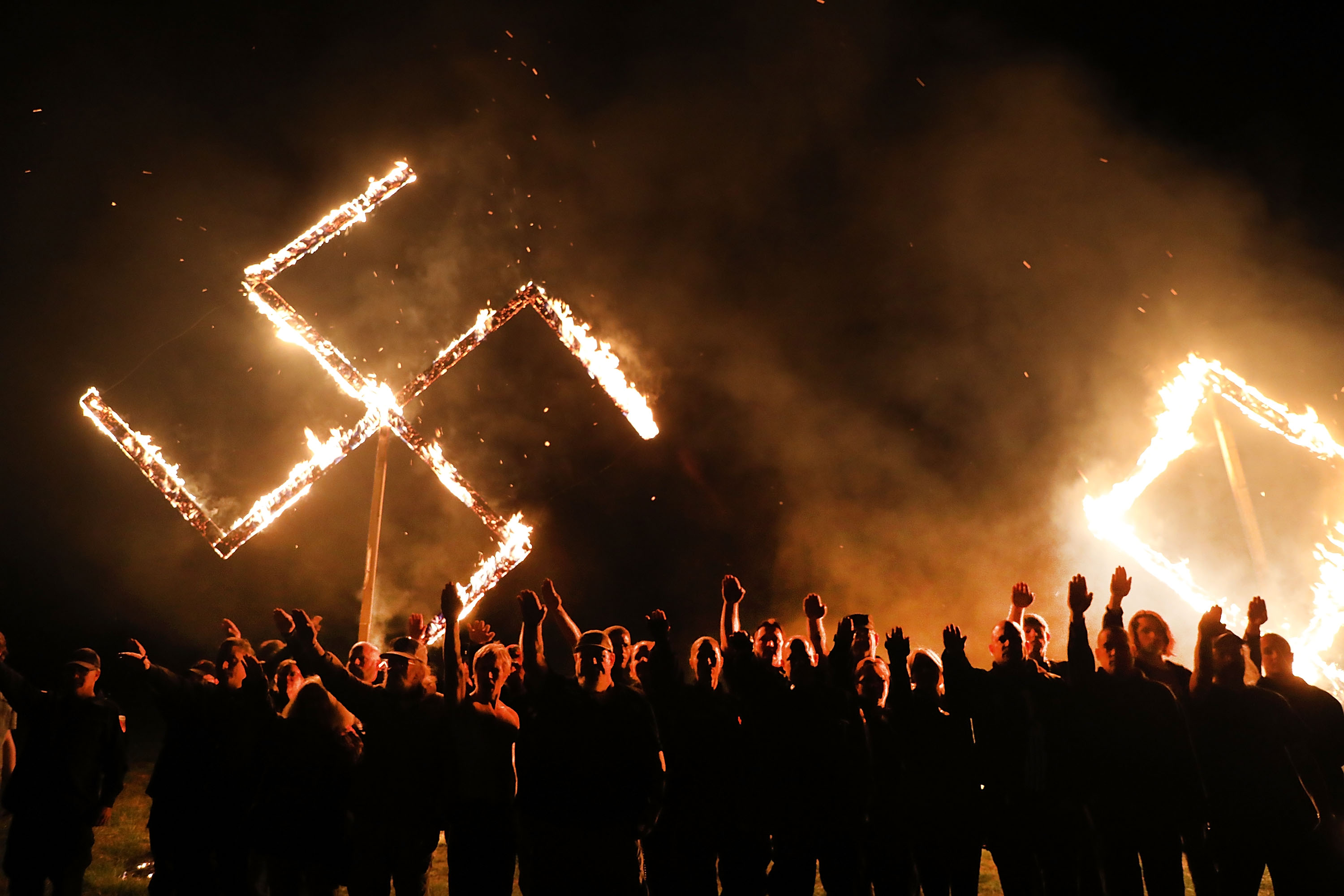The growing white supremacist threat
In the wake of the Jan. 6 insurrection, federal officials are warning of more attacks by 'violent domestic extremists'

In the wake of the Jan. 6 insurrection, federal officials are warning of more attacks by 'violent domestic extremists.' Here's everything you need to know:
What are the extremists' goals?
"Far-right extremism" encompasses a broad number of groups whose specific beliefs and goals vary. They fall into two broad, overlapping categories: white supremacist groups who believe they must defend the white race from "extinction," and anti-government paramilitary groups, or militias, who see themselves as revolutionary heroes opposing a tyrannical federal government and the "New World Order" — a secretive global government run by Jews and socialists. Some militias are dedicated to the violent overthrow of the U.S. government; some "accelerationists," such as the Boogaloo Bois, aim to spark a civil war between the races and to establish the U.S. as a white, Christian ethno-state. The violent attack on the Capitol, law enforcement officials say, was spearheaded by these groups, all of which, says Kathleen Belew, a University of Chicago historian who studies white supremacists are "fundamentally opposed to the exercise of American democracy."
The Week
Escape your echo chamber. Get the facts behind the news, plus analysis from multiple perspectives.

Sign up for The Week's Free Newsletters
From our morning news briefing to a weekly Good News Newsletter, get the best of The Week delivered directly to your inbox.
From our morning news briefing to a weekly Good News Newsletter, get the best of The Week delivered directly to your inbox.
When did the militia movement begin?
While armed anti-government groups are a longtime presence in the U.S., the modern militia movement dates to the 1980s. It grew in response to the election of President Bill Clinton in 1992 and the subsequent passage of gun restrictions, including the assault weapons ban in 1994 — which alarmed those who see all gun restrictions as a form of tyranny. Two incidents in this era galvanized the movement. The first was a 1992 standoff in Ruby Ridge, Idaho, where federal agents executing a warrant on a white supremacist killed his wife and son in a shoot-out. Then in 1993, a federal siege of the Branch Davidians compound in Waco, Texas, led to a firefight and a fire that caused the deaths of 82 members of the religious sect. In 1995, Timothy McVeigh — an army veteran with ties to militia and white supremacist groups — detonated a massive truck bomb that destroyed a federal building in Oklahoma City, killing 168 people and injuring more than 680. After the national revulsion over that attack, militia activity dropped significantly. But it came back with a vengeance in 2008.
What happened in 2008?
The election of the country's first black president, Barack Obama, which horrified far-right extremists. Experts say the 2008 economic collapse deepened their fears and cynicism, while Facebook and other social media facilitated recruitment efforts. Two of the most prominent anti-government groups emerged around this time: the Oath Keepers, a militia focused on rallying former military and police to "honor their oath against tyranny," and the Three Percenters, whose name refers to the supposed percentage of Americans who took up arms against tyrannical British rule during the Revolutionary War. In 2009, the Department of Homeland Security issued a report warning of a dangerous surge in right-wing extremism — which was withdrawn after conservatives charged that the Obama administration was trying to criminalize and suppress dissent.
A free daily email with the biggest news stories of the day – and the best features from TheWeek.com
How many people are involved?
Experts estimate there are now tens of thousands of far-right extremists connected to several hundred groups. The Southern Poverty Law Center identified 576 "extreme anti-government groups" in 2019, 181 of them militias. The group counted 155 "white nationalist hate groups" the same year, a 55 percent increase over 2017. But experts caution that such groups' influence extends far beyond the people who identify themselves as members. Just as ISIS's online propaganda spawned "lone wolf" attacks, law enforcement officials say, white supremacist rhetoric helped inspire Patrick Crusius, 22, to open fire on Hispanics at a Walmart in El Paso, Texas, killing 23, and Dylann Roof, 26, who murdered nine black parishioners in a church in Charleston, South Carolina.
Why is the threat growing?
A major factor, experts who study white supremacists say, is the election and rhetoric of Donald Trump. His outspoken anti-immigrant stance and defense of the white supremacists who marched in Charlottesville in 2017 ("very fine people") electrified extremist groups, who believed the president of the U.S. was signaling his approval. With Trump, "the fringe entered the mainstream," said Lawrence Rosenthal of the Center for Right-Wing Studies at the University of California, Berkeley. Militias were further mobilized by government restrictions in response to the pandemic, which they see as tyrannical overreach, and the rise of the Black Lives Matter movement. White supremacists and militia members clashed with BLM demonstrators across the country last summer, and protested pandemic restrictions at many state capitols. In Michigan, 14 militia members were charged with developing an advanced plot to kidnap Gov. Gretchen Whitmer and try her for treason. Following the Jan. 6 Capitol insurrection, authorities found strong evidence that militias played a central role in organizing and directing the attack.
What's being done?
President Biden vowed in his inaugural address to confront "a rise in political extremism, white supremacy, [and] domestic terrorism." He's ordered the director of national intelligence to work with the FBI and DHS to compile a comprehensive assessment. But even as that assessment begins, experts warn that the Capitol attack and the Democrats' return to power have further energized far-right extremists, and that a long and fraught conflict lies ahead. Lindsay Schubiner, a program director at the Western States Center who studies white nationalism, said, "This isn't something that can be put back in the bottle."
The role of military veterans
Law enforcement officials who track militias and other extremist groups cite a growing worry: a rising number of military veterans within their ranks. Experts say veterans and active-duty military may compose up to 25 percent of militia members. Several groups have been founded by veterans, including the Oath Keepers, which actively recruits former police and military members. Militias have a history of targeting veterans for recruitment "because they have operational skills that are useful," said historian Kathleen Belew, who studies far-right groups. She warns that because of their experience with tactical planning, weapons, and explosives, veterans can have an "enormous impact on the level of violence white-power groups can carry out." Nearly 20 percent of those charged with crimes in the Capitol insurrection thus far are veterans or active-duty soldiers. Congressional lawmakers have called on the Pentagon to investigate and address extremism within the ranks.
This article was first published in the latest issue of The Week magazine. If you want to read more like it, you can try six risk-free issues of the magazine here.
-
 What will happen in 2026? Predictions and events
What will happen in 2026? Predictions and eventsIn Depth The new year could bring peace in Ukraine or war in Venezuela, as Donald Trump prepares to host a highly politicised World Cup and Nasa returns to the Moon
-
 Why is Trump’s alleged strike on Venezuela shrouded in so much secrecy?
Why is Trump’s alleged strike on Venezuela shrouded in so much secrecy?TODAY'S BIG QUESTION Trump’s comments have raised more questions than answers about what his administration is doing in the Southern Hemisphere
-
 Vance’s ‘next move will reveal whether the conservative movement can move past Trump’
Vance’s ‘next move will reveal whether the conservative movement can move past Trump’Instant Opinion Opinion, comment and editorials of the day
-
 Bari Weiss’ ‘60 Minutes’ scandal is about more than one report
Bari Weiss’ ‘60 Minutes’ scandal is about more than one reportIN THE SPOTLIGHT By blocking an approved segment on a controversial prison holding US deportees in El Salvador, the editor-in-chief of CBS News has become the main story
-
 Has Zohran Mamdani shown the Democrats how to win again?
Has Zohran Mamdani shown the Democrats how to win again?Today’s Big Question New York City mayoral election touted as victory for left-wing populists but moderate centrist wins elsewhere present more complex path for Democratic Party
-
 Millions turn out for anti-Trump ‘No Kings’ rallies
Millions turn out for anti-Trump ‘No Kings’ ralliesSpeed Read An estimated 7 million people participated, 2 million more than at the first ‘No Kings’ protest in June
-
 Ghislaine Maxwell: angling for a Trump pardon
Ghislaine Maxwell: angling for a Trump pardonTalking Point Convicted sex trafficker's testimony could shed new light on president's links to Jeffrey Epstein
-
 The last words and final moments of 40 presidents
The last words and final moments of 40 presidentsThe Explainer Some are eloquent quotes worthy of the holders of the highest office in the nation, and others... aren't
-
 The JFK files: the truth at last?
The JFK files: the truth at last?In The Spotlight More than 64,000 previously classified documents relating the 1963 assassination of John F. Kennedy have been released by the Trump administration
-
 'Seriously, not literally': how should the world take Donald Trump?
'Seriously, not literally': how should the world take Donald Trump?Today's big question White House rhetoric and reality look likely to become increasingly blurred
-
 Will Trump's 'madman' strategy pay off?
Will Trump's 'madman' strategy pay off?Today's Big Question Incoming US president likes to seem unpredictable but, this time round, world leaders could be wise to his playbook